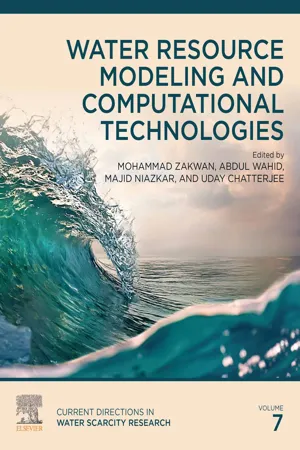
eBook - ePub
Water Resource Modeling and Computational Technologies
- 720 pages
- English
- ePUB (mobile friendly)
- Available on iOS & Android
eBook - ePub
Water Resource Modeling and Computational Technologies
About this book
Water Resource Modeling and Computational Technologies, Seventh Edition provides the reader with a comprehensive overview of the applications that computational techniques have in various sectors of water resource engineering. The book explores applications of recent modeling and computational techniques in various sectors of water resource engineering, including hydroinformatics, irrigation engineering, climate change, hydrologic forecasting, floods, droughts, image processing, GIS, water quality, aquifer mapping, basin scale modeling, computational fluid dynamics, numerical modeling of surges and groundwater flow, river engineering, optimal reservoir operation, multipurpose projects, and water resource management. As such, this is a must read for hydrologists, civil engineers and water resource managers.
- Presents contributed chapters from global experts in the field of water resources from both a science and engineering perspective
- Includes case studies throughout, providing readers with an opportunity to understand how case specific challenges can help with computational techniques
- Provides basic concepts as well as a literature review on the application of computational techniques in various sectors of water resources
Frequently asked questions
Yes, you can cancel anytime from the Subscription tab in your account settings on the Perlego website. Your subscription will stay active until the end of your current billing period. Learn how to cancel your subscription.
At the moment all of our mobile-responsive ePub books are available to download via the app. Most of our PDFs are also available to download and we're working on making the final remaining ones downloadable now. Learn more here.
Perlego offers two plans: Essential and Complete
- Essential is ideal for learners and professionals who enjoy exploring a wide range of subjects. Access the Essential Library with 800,000+ trusted titles and best-sellers across business, personal growth, and the humanities. Includes unlimited reading time and Standard Read Aloud voice.
- Complete: Perfect for advanced learners and researchers needing full, unrestricted access. Unlock 1.4M+ books across hundreds of subjects, including academic and specialized titles. The Complete Plan also includes advanced features like Premium Read Aloud and Research Assistant.
We are an online textbook subscription service, where you can get access to an entire online library for less than the price of a single book per month. With over 1 million books across 1000+ topics, we’ve got you covered! Learn more here.
Look out for the read-aloud symbol on your next book to see if you can listen to it. The read-aloud tool reads text aloud for you, highlighting the text as it is being read. You can pause it, speed it up and slow it down. Learn more here.
Yes! You can use the Perlego app on both iOS or Android devices to read anytime, anywhere — even offline. Perfect for commutes or when you’re on the go.
Please note we cannot support devices running on iOS 13 and Android 7 or earlier. Learn more about using the app.
Please note we cannot support devices running on iOS 13 and Android 7 or earlier. Learn more about using the app.
Yes, you can access Water Resource Modeling and Computational Technologies by Mohammad Zakwan,Abdul Wahid,Majid Niazkar,Uday Chatterjee in PDF and/or ePUB format, as well as other popular books in Biological Sciences & Business Intelligence. We have over one million books available in our catalogue for you to explore.
Information
Table of contents
- Cover image
- Title page
- Table of Contents
- Series Page
- Copyright
- Contributors
- About the editors
- Foreword
- Preface
- Acknowledgments
- Section I: Introduction
- Chapter 1: Artificial intelligence and machine learning in water resources engineering
- Section II: Application of artificial intelligence to water resources
- Chapter 2: Demystifying artificial intelligence amidst sustainable agricultural water management
- Section III: Image processing applications in water resources
- Chapter 6: Assessment of water resources using remote sensing and GIS techniques
- Section IV: Advances in hydroinformatics mitigation
- Chapter 15: Random vector functional link network based on variational mode decomposition for predicting river water turbidity
- Section V: Advances in watershed modelling
- Chapter 19: Theoretical background and application of numerical modeling to surface water resources
- Section VI: Advances in numerical modelling in water resources
- Chapter 22: Multiphysics modeling of groundwater flow on the example of a coupled thermo-hydro-mechanical model of infiltration of water warmer or cooler than the surroundings
- Chapter 23: Hydrosalinity modeling of water and salt dynamics in irrigated soil groundwater systems
- Section VII: Optimization techniques and analytical formulations in water resource
- Chapter 24: Multiobjective optimization techniques for integrated urban water management: A case study of Varanasi city
- Section VIII: Advances in sediment transport modelling and river engineering
- Chapter 27: The hole size analysis of bursting events around mid-channel bar using the conditional method approach
- Section IX: Computational intelligence in extreme hydrology: flood and droughts
- Chapter 30: Understanding trend and its variability of rainfall and temperature over Patna (Bihar)
- Index